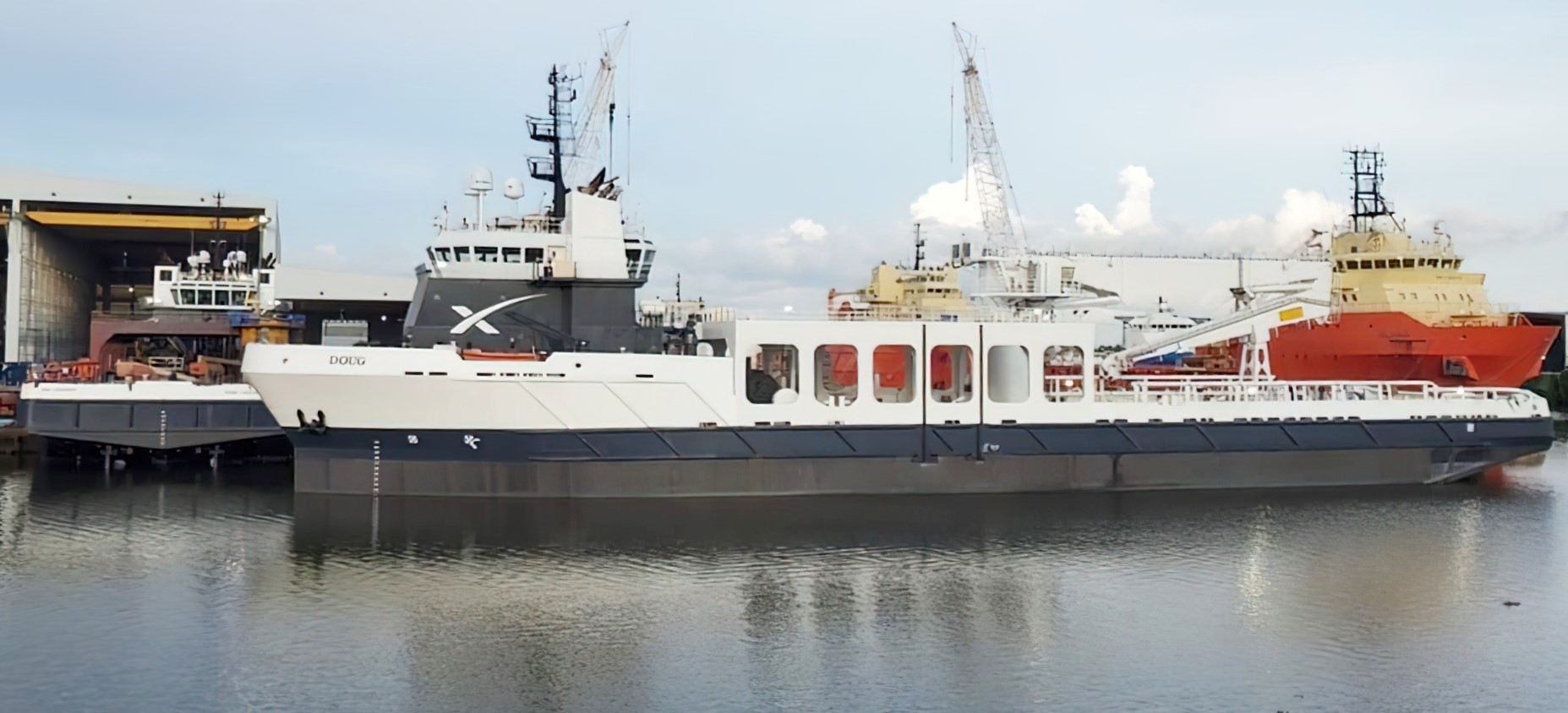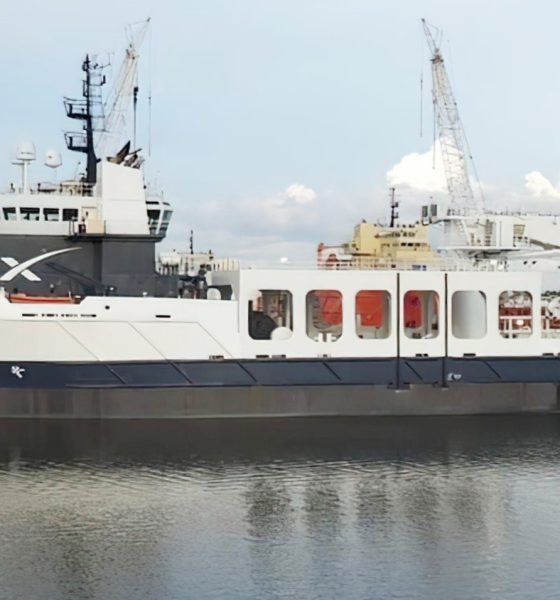

News
SpaceX’s fleet of rocket recovery ships is about to get even bigger
Four months after SpaceX gave up on catching Falcon fairings and stripped and returned a pair of leased ships it had modified for that purpose, the company’s permanent fairing recovery solution has just come into focus.
The April 2021 departure of GO Ms Tree (formerly Mr. Steven) and GO Ms Chief from SpaceX’s East Coast fleet made it unambiguously clear that the company was abandoning fairing catching in favor of simply scooping the several million dollar nose cone halves off of the surface of the ocean. By the time that decision was made, SpaceX had reused fairing halves more than two dozen times on more than 15 Falcon 9 launches – practically none of which had actually been caught by Ms Tree or Ms Chief.
In fact, SpaceX had already begun to reuse ‘scooped’ fairing halves on commercial Falcon 9 launches, including two Transporter rideshare missions with dozens of different customers and SiriusXM’s SXM-7 multimillion-dollar geostationary communications satellite. Perhaps even more importantly, SpaceX was routinely flying splashdown fairing halves three or even four times and flew one particular half twice in just 49 days.
Put simply, thanks to the heroic and somewhat unexpected success of a small subset of SpaceX’s fairing recovery, waterproofing, design improvements, and refurbishment upgrades got so good even fairings that splashed down in the Atlantic Ocean could be rapidly reused and flown multiple (now 5+) times apiece. Onto its third consecutive year of only marginal success and a distinct lack of reliability, that meant that SpaceX’s long-struggling effort to catch Falcon fairings had effectively been made redundant.
While it’s likely that scooped fairing halves would never be certified to fly high-value US military or NASA payloads, SpaceX appears to have matured the technology to the point that it’s good enough for Starlink and many (if not most) of its private-sector launch customers. Along those lines, with Ms Tree and Ms Chief out of the picture by early April, SpaceX had to briefly shoehorn Dragon recovery ships GO Navigator and GO Searcher into scooping roles to continue recovering fairings and eventually decided to lease or rent two far larger ships with built-in deck cranes.
For whatever reason, those leases or rentals only lasted a handful of weeks apiece and the latest ship – Hos Briarwood – departed SpaceX’s fleet in early July. In an extremely rare impromptu hiatus, SpaceX hasn’t launched once since late June, likely explaining why Briarwood – with a 100% fairing recovery success rate over two missions – departed when it did.
Now, first reported by SpaceExplored.com, the first signs of SpaceX’s long-expected permanent fairing recovery solution have appeared at an obscure Louisiana drydock. By all appearances, for the first time in its history, SpaceX has outright purchased two decade-old offshore supply ships formerly known as Ingrid and Ella G. Thankfully, SpaceX wiped clean any hint of ambiguity with the installation of a classic SpaceX “X” and by renaming the ships “Bob” and “Doug” after the pair that became the first NASA astronauts to ride a Falcon 9 rocket and Crew Dragon spacecraft to orbit in May 2020.
Relative to any of SpaceX’s more permanent fleet, including ex-members Tree and Chief, Bob and Doug are massive ships, measuring more than 80m (260 feet) long. They’re also five or six times heavier than the likes of GO Searcher or Ms Tree. Aside from an obvious potential role as fairing ‘scoopers’ thanks to the installation of large deck cranes, Bob and Doug also appear to have had heavy-duty winches installed, implying that they could also double as drone ship towboats.
Potentially, that means that SpaceX could shrink the fleet of ships needed to support each drone ship booster landing from two to one, using Bog and Doug to both tow and service the landing platforms at sea.

Elon Musk
Elon Musk’s X will start using a Tesla-like software update strategy
The initiative seems designed to accelerate updates to the social media platform, while maintaining maximum transparency.

Elon Musk’s social media platform X will adopt a Tesla-esque approach to software updates for its algorithm.
The initiative seems designed to accelerate updates to the social media platform, while maintaining maximum transparency.
X’s updates to its updates
As per Musk in a post on X, the social media company will be making a new algorithm to determine what organic and advertising posts are recommended to users. These updates would then be repeated every four weeks.
“We will make the new 𝕏 algorithm, including all code used to determine what organic and advertising posts are recommended to users, open source in 7 days. This will be repeated every 4 weeks, with comprehensive developer notes, to help you understand what changed,” Musk wrote in his post.
The initiative somewhat mirrors Tesla’s over-the-air update model, where vehicle software is regularly refined and pushed to users with detailed release notes. This should allow users to better understand the details of X’s every update and foster a healthy feedback loop for the social media platform.
xAI and X
X, formerly Twitter, has been acquired by Elon Musk’s artificial intelligence startup, xAI last year. Since then, xAI has seen a rapid rise in valuation. Following the company’s the company’s upsized $20 billion Series E funding round, estimates now suggest that xAI is worth tens about $230 to $235 billion. That’s several times larger than Tesla when Elon Musk received his controversial 2018 CEO Performance Award.
As per xAI, the Series E funding round attracted a diverse group of investors, including Valor Equity Partners, Stepstone Group, Fidelity Management & Research Company, Qatar Investment Authority, MGX, and Baron Capital Group, among others. Strategic partners NVIDIA and Cisco Investments also continued support for building the world’s largest GPU clusters.
News
Tesla FSD Supervised wins MotorTrend’s Best Driver Assistance Award
The decision marks a notable reversal for the publication from prior years, with judges citing major real-world improvements that pushed Tesla’s latest FSD software ahead of every competing ADAS system.

Tesla’s Full Self-Driving (Supervised) system has been named the best driver-assistance technology on the market, earning top honors at the 2026 MotorTrend Best Tech Awards.
The decision marks a notable reversal for the publication from prior years, with judges citing major real-world improvements that pushed Tesla’s latest FSD software ahead of every competing ADAS system. And it wasn’t even close.
MotorTrend reverses course
MotorTrend awarded Tesla FSD (Supervised) its 2026 Best Tech Driver Assistance title after extensive testing of the latest v14 software. The publication acknowledged that it had previously criticized earlier versions of FSD for erratic behavior and near-miss incidents, ultimately favoring rivals such as GM’s Super Cruise in earlier evaluations.
According to MotorTrend, the newest iteration of FSD resolved many of those shortcomings. Testers said v14 showed far smoother behavior in complex urban scenarios, including unprotected left turns, traffic circles, emergency vehicles, and dense city streets. While the system still requires constant driver supervision, judges concluded that no other advanced driver-assistance system currently matches its breadth of capability.
Unlike rival systems that rely on combinations of cameras, radar, lidar, and mapped highways, Tesla’s FSD operates using a camera-only approach and is capable of driving on city streets, rural roads, and freeways. MotorTrend stated that pure utility, the ability to handle nearly all road types, ultimately separated FSD from competitors like Ford BlueCruise, GM Super Cruise, and BMW’s Highway Assistant.
High cost and high capability
MotorTrend also addressed FSD’s pricing, which remains significantly higher than rival systems. Tesla currently charges $8,000 for a one-time purchase or $99 per month for a subscription, compared with far lower upfront and subscription costs from other automakers. The publication noted that the premium is justified given FSD’s unmatched scope and continuous software evolution.
Safety remained a central focus of the evaluation. While testers reported collision-free operation over thousands of miles, they noted ongoing concerns around FSD’s configurable driving modes, including options that allow aggressive driving and speeds beyond posted limits. MotorTrend emphasized that, like all Level 2 systems, FSD still depends on a fully attentive human driver at all times.
Despite those caveats, the publication concluded that Tesla’s rapid software progress fundamentally reshaped the competitive landscape. For drivers seeking the most capable hands-on driver-assistance system available today, MotorTrend concluded Tesla FSD (Supervised) now stands alone at the top.
News
Elon Musk’s Grokipedia surges to 5.6M articles, almost 79% of English Wikipedia
The explosive growth marks a major milestone for the AI-powered online encyclopedia, which was launched by Elon Musk’s xAI just months ago.

Elon Musk’s Grokipedia has grown to an impressive 5,615,201 articles as of today, closing in on 79% of the English Wikipedia’s current total of 7,119,376 articles.
The explosive growth marks a major milestone for the AI-powered online encyclopedia, which was launched by Elon Musk’s xAI just months ago. Needless to say, it would only be a matter of time before Grokipedia exceeds English Wikipedia in sheer volume.
Grokipedia’s rapid growth
xAI’s vision for Grokipedia emphasizes neutrality, while Grok’s reasoning capabilities allow for fast drafting and fact-checking. When Elon Musk announced the initiative in late September 2025, he noted that Grokipedia would be an improvement to Wikipedia because it would be designed to avoid bias.
At the time, Musk noted that Grokipedia “is a necessary step towards the xAI goal of understanding the Universe.”
Grokipedia was launched in late October, and while xAI was careful to list it only as Version 0.1 at the time, the online encyclopedia immediately earned praise. Wikipedia co-founder Larry Sanger highlighted the project’s innovative approach, noting how it leverages AI to fill knowledge gaps and enable rapid updates. Netizens also observed how Grokipedia tends to present articles in a more objective manner compared to Wikipedia, which is edited by humans.
Elon Musk’s ambitious plans
With 5,615,201 total articles, Grokipedia has now grown to almost 79% of English Wikipedia’s article base. This is incredibly quick, though Grokipedia remains text-only for now. xAI, for its part, has now updated the online encyclopedia’s iteration to v0.2.
Elon Musk has shared bold ideas for Grokipedia, including sending a record of the entire knowledge base to space as part of xAI’s mission to preserve and expand human understanding. At some point, Musk stated that Grokipedia will be renamed to Encyclopedia Galactica, and it will be sent to the cosmos.
“When Grokipedia is good enough (long way to go), we will change the name to Encyclopedia Galactica. It will be an open source distillation of all knowledge, including audio, images and video. Join xAI to help build the sci-fi version of the Library of Alexandria!” Musk wrote, adding in a later post that “Copies will be etched in stone and sent to the Moon, Mars and beyond. This time, it will not be lost.”








